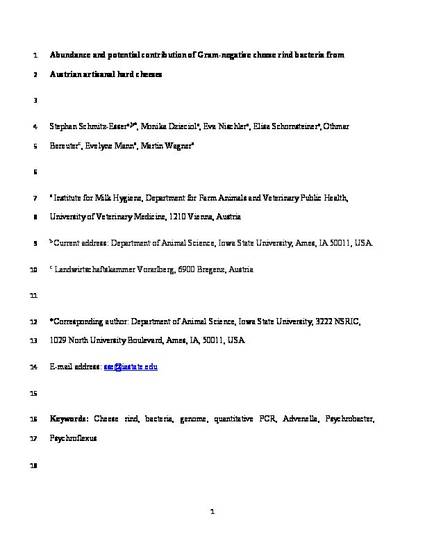
Many different Gram-negative bacteria have been shown to be present on cheese rinds. Their contribution to cheese ripening is however, only partially understood until now. Here, cheese rind samples were taken from Vorarlberger Bergkäse (VB), an artisanal hard washed-rind cheese from Austria. Ripening cellars of two cheese production facilities in Austria were sampled at the day of production and after 14, 30, 90 and 160 days of ripening. To obtain insights into the possible contribution of Advenella, Psychrobacter, and Psychroflexus to cheese ripening, we sequenced and analyzed the genomes of one strain of each genus isolated from VB cheese rinds. Additionally, quantitative PCRs (qPCRs) were performed to follow the abundance of Advenella, Psychrobacter, and Psychroflexus on VB rinds during ripening in both facilities. qPCR results showed that Psychrobacter was most abundant on cheese rinds and the abundance of Advenella decreased throughout the first month of ripening and increased significantly after 30 days of ripening (p<0.01). Psychrobacter and Psychroflexus increased significantly during the first 30 ripening days (p<0.01), and decreased to their initial abundance during the rest of the ripening time (p<0.05). Genome sequencing resulted in 17 to 27 contigs with assembly sizes of 2.7 Mbp for Psychroflexus, 3 Mbp for Psychrobacter, and 4.3 Mbp for Advenella. Our results reveal that each genome harbors enzymes shown to be important for cheese ripening in other bacteria such as: Cystathionine/Methionine beta or gamma-Lyases, many proteases and peptidases (including proline iminopeptidases), aminotransferases, and lipases. Thus, all three isolates have the potential to contribute positively to cheese ripening. In conclusion, the three species quantified were stable community members throughout the ripening process and their abundance on cheese rinds together with the results from genome sequencing suggest an important contribution of these bacteria to cheese ripening.
Available at: http://works.bepress.com/stephan-schmitz-esser/43/

This is a manuscript of an article published as Schmitz-Esser, Stephan, Monika Dzieciol, Eva Nischler, Elisa Schornsteiner, Othmar Bereuter, Evelyne Mann, and Martin Wagner. "Abundance and potential contribution of Gram-negative cheese rind bacteria from Austrian artisanal hard cheeses." International journal of food microbiology 266 (2018): 95-103. doi: 10.1016/j.ijfoodmicro.2017.11.013. Posted with permission.